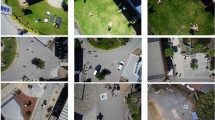Abstract
In recent days, people in remote area suffer a lot due to variety of natural calamities such as flooding, earthquake and so on. It has been noted that people used to stay in top portions of their house when there is a flooding issue. Hence, it is very difficult for the rescue team to identify the location of a person by looking at the parts of a person such as hands, legs and partial image of a face using the existing approaches. In this proposed approach, an idea for detecting person when there is only parts such as legs, hands are visible from remote, wild or non-urban areas with the help of UAV-Unmanned Aerial Vehicle has been suggested. Detecting person and identifying the location from the image tends to be a difficult process due to very small and camouflaged objects in the images collected. In this approach, Semantic Segmentation using deep learning approach has been applied in order to detect a person. SegNet- Segmentation Network is the network architecture used in the process of semantically segment the image according to each pixel, hence identifying person is easy. The main objective of this proposed model is that, sometime UAV image may contain partial person images, like legs, hand, etc., that could not be identified by existing approaches were being recognized and identified successfully. This model is trained and tested using HERIDAL dataset. Over 70% images were trained and 30% images were used for testing. This enhanced deep learning model named as Semantic SegNet model achieved an accuracy of 91.04%. This proposed Semantic SegNet model has been compared with existing approaches such as VGG16, GoogleNet and ResNet- Residual neural Network for the same set of trained and tested images. Comparison table declared that this proposed Semantic SegNet Model outperformed other existing models.
















Similar content being viewed by others
References
Angelova, A, Krizhevsky, A, Vanhoucke, V, Ogale, A and Ferguson, D (2015). Real-time pedestrian detection with deep network cascades. In Proceedings of BMVC 2015
Anna Gaszczak, JH and Breckon, Toby P (2011). Real-time people and vehicle detection from UAV imagery (Vol. 7878, pp. 7878–7878- 13)
Vijay Badrinarayanan, Alex Kendall and Roberto Cipolla (2017). SegNet: A Deep Convolutional Encoder-Decoder Architecture for Image Segmentation. PAMI
CAB Baker, S Ramchurn, WT Teacy, NR Jennings (2016). Planning search and rescue missions for UAV teams, proceedings of the twenty-second European conference on artificial intelligence, Netherlands, IOS Press
Božić-Štulić D, Marušić Ž, Gotovac S (2019) Deep learning approach in aerial imagery for supporting land search and rescue missions. Int J Comput Vis 127:1256–1278
Chenyi Chen, Ming-Yu Liu, Oncel Tuzel, Jianxiong Xiao (2017). R-CNN for Small Object Detection. Springer International Publishing AG, (pp. 214–230)
R Girshick (2015). Fast r-cnn. In International Conference on Computer Vision (ICCV)
Harold Robinson Y, Golden Julie E (2019) SMR: A Synchronized Multipath Rebroadcasting Mechanism for Improving the Quality of Conversational Video Service. Wirel Pers Commun 104(3):1149–1173
K. He, X. Zhang, S. Ren, and J. Sun (2015). Deep residual learning for image recognition. arXiv preprint arXiv:1512.03385
Hanno Hildmann and Ernö Kovacs (2019). Review: using unmanned aerial vehicles (UAVs) as Mobile sensing platforms (MSPs) for disaster response, Civil Security and Public Safety.Drones
Deepak Jaiswal ,Praveen Kumar (2019). Real-time implementation of moving object detection in UAV videos using GPUs. J Real-Time Image Proc
J Joshua Bapu, D Jemi Florinabel, Y Harold Robinson, E Golden Julie, Raghvendra Kumar, Vo Truong Nhu Ngoc, Le Hoang Son, Tran Manh Tuan, Cu Nguyen Giap (2019). “Adaptive convolutional neural network using N-gram for spatial object recognition”, Earth Science Informatics, pp 1–16
A Krizhevsky, I Sutskever, and GE Hinton (2012). Imagenet classification with deep convolutional neural networks. In Advances in neural information processing systems, pages 1097–1105
LichaoMou, YuanshengHua, Pu Jin, and Xiao Xiang Zhu. ERA: A Dataset and Deep Learning Benchmark for Event Recognition in Aerial Videos
Mohammad Najafzadeh and Abdolreza Zahiri (2015). Neuro-Fuzzy GMDH-Based Evolutionary Algorithms to Predict Flow Discharge in Straight Compound Channels, https://doi.org/10.1061/(ASCE)HE.1943-5584.0001185, 20, 04015035
H Nam and B Han (2015). Learning multi-domain convolutional neural networks for visual tracking. arXiv preprint arXiv:1510.07945
J Redmon, S Divvala, R Girshick, and A Farhadi (2015). You only look once: Unified, real-time object detection. arXiv preprint arXiv:1506.02640
S Ren, K He, RB Girshick, and J Sun (2015). Faster R-CNN: towards real-time object detection with region proposal networks. CoRR, abs/1506.01497
Rudol, P and Doherty, P (2008). Human body detection and geolocalization for UAV search and rescue missions using color and thermal imagery. In 2008 IEEE aerospace conference (pp. 1–8)
K Simonyan and A Zisserman (2014). Very deep convolutional networks for large-scale image recognition. arXiv preprint arXiv:1409.1556
C Szegedy, W Liu, Y Jia, P Sermanet, S Reed, D Anguelov, D Erhan, V Vanhoucke, and A Rabinovich (2015). Going deeper with convolutions. In Proceedings of the IEEE Conference on Computer Vision and Pattern Recognition, pages 1–9
Tian, Y, Luo, P, Wang, X and Tang, X (2015). Deep learning strong parts for pedestrian detection. In: 2015 IEEE international conference on computer vision (ICCV) (pp. 1904–1912)
Turić H, Dujmić H, Papić V (2010) Two-stage segmentation of aerial images for search and rescue. Information Technology and Control 39:138–145
Viola, P, Jones, MJ and Snow, D (2003). Detecting pedestrians using patterns of motion and appearance. In proceedings ninth IEEE international conference on computer vision (Vol. 2, pp. 734–741)
Abdolreza Zahiri and Mohammad Najafzadeh (2018). Optimized expressions to evaluate the flow discharge in main channels and floodplains using evolutionary computing and model classification, International Journal of River Basin Management, Volume 16, - Issue 1
Matthew D. Zeiler and Rob Fergus (2013). Visualizing and Understanding Convolutional Network
Author information
Authors and Affiliations
Corresponding author
Additional information
Communicated by: H. Babaie
Publisher’s note
Springer Nature remains neutral with regard to jurisdictional claims in published maps and institutional affiliations.
Rights and permissions
About this article
Cite this article
Manickam, R., Kumar Rajan, S., Subramanian, C. et al. Person identification with aerial imaginary using SegNet based semantic segmentation. Earth Sci Inform 13, 1293–1304 (2020). https://doi.org/10.1007/s12145-020-00516-y
Received:
Accepted:
Published:
Issue Date:
DOI: https://doi.org/10.1007/s12145-020-00516-y




